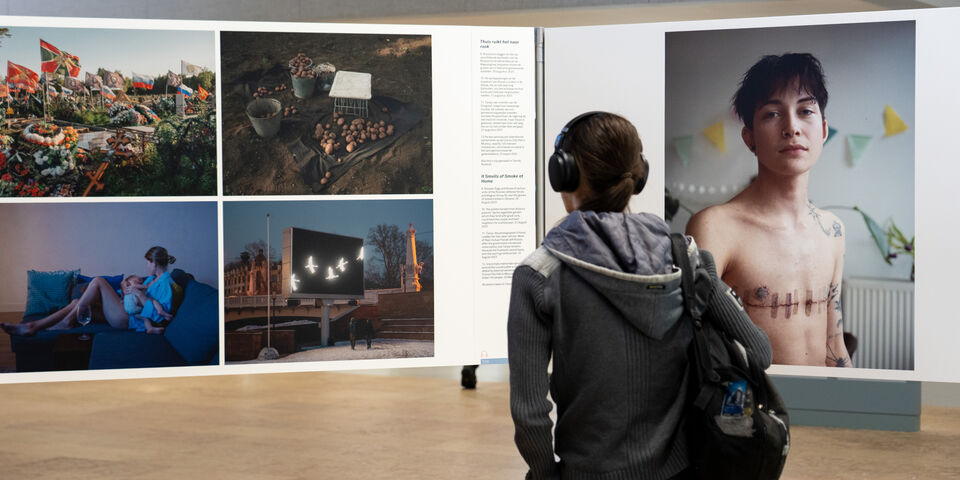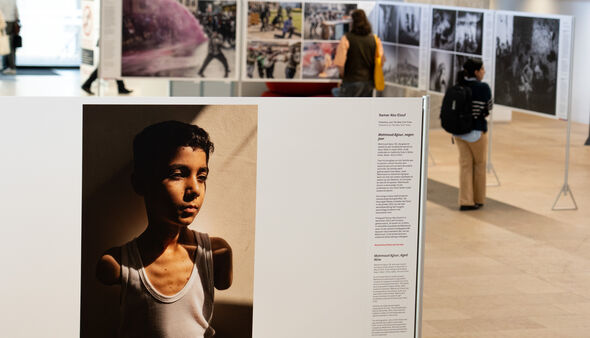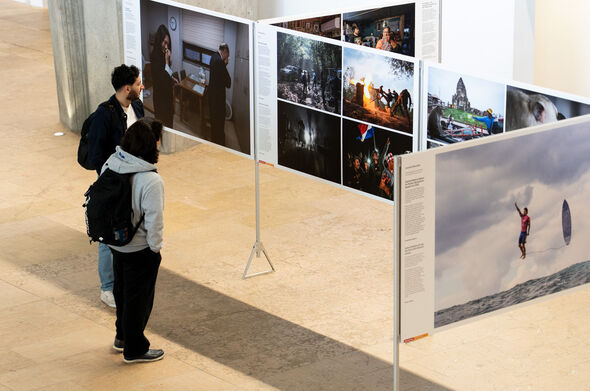Serenity versus horror in World Press Photo Exhibition
World Press Photo is celebrating its 70th anniversary this year, but the photos of the exhibition in the Atlas building are anything but festive: war, natural disasters, and oppression dominate. The images are impressive and compelling, however, because they “connect the world to stories that matter,” according to TU/e student Arne Lubbers, Cursor's guide.
“What impresses you more: the shocking, sometimes even gory photos, or the more serene images?” We are gathered with a small group in the lobby of Atlas, where a selection of the best press photos from around the world is currently on display.
World Press Photo was founded in the Netherlands in 1955 and, thanks to Studium Generale, is now visiting TU/e for the 22nd time. The captions and audio guide provide plenty of context for the photos, but you can also take part in a short guided tour. Our guide, Arne Lubbers, is a master's student in Human-Technology Interaction and Data Science and a member of the Dekate Mousa photography association.
Mahmoud
Back to the question of which photos move us the most. Lubbers asks this as we look at the Photo of the Year: the overall winner, chosen from nearly sixty thousand entries. It is a portrait of nine-year-old Mahmoud Ajjour, who lost both arms in a bombing in Gaza.
The photographer, also from Gaza, managed to flee to Qatar, as did the Ajjour family. There she met Mahmoud. He had the courage to appear before her lens without concealing himself in long-sleeved clothing. Yet it is the boy's shaded gaze that draws all the attention. One moment I see despair, the next calmness and trust.
Lubbers points to other photos in which the horror of war is much more directly visible. We come to the shared conclusion that it is precisely this contrast that makes both the gruesome and the serene photos so deeply moving. The guide concludes on a positive note: Mahmoud has meanwhile received two prosthetic arms, making a major wish come true. His sleeves are no longer empty.
Adoption fraud
A woman and an older man are standing in a room. Both are wiping away tears, but they are not holding each other. We see American Nicole Motta, says Lubbers, who is reunited with her biological father after almost forty years. The intimate photo tells the story of adoption fraud in South Korea. Motta was given away by her family in 1985 while her unsuspecting father was away on a business trip. Until recently, she thought she had been an orphan.
Fortunately, more and more countries are taking measures to put a stop to the abuses of the ‘adoption industry’, Lubbers points out, adding a hopeful side to the story. He uses the photo to highlight one of World Press Photo’s most important objectives: to “connect the world to stories that matter.” The photos on display come from six different regions around the world, each with its own jury, to prevent the photos from being judged too much from a Western perspective.
Tank Man
In relation to the important stories told by World Press Photo, the guide also refers to an iconic image that was Photo of the Year in 1990. It is the photo of ‘Tank Man’, an unknown man who, following blood-stained protests on Tiananmen Square in Beijing, single-handedly forced four tanks to stop. “In China, it is still illegal to have this photo in your possession.”
Which brings us to an important theme for World Press Photo: freedom of the press. In that respect, 2024 was the bloodiest year ever, according to the organization's sad conclusion. At least 103 journalists were killed, 70 percent of them by Israeli forces. “The ‘press’ emblem that journalists wear on their bulletproof vests for protection in the battlefield now serves as a target,” Lubbers outlines the grim state of affairs.
Tear gas
Still, award-winning photos can also come from countries where there's no freedom of the press. Like a series of photos of the civil protests last November in Georgia. One of the pictures shows a young woman rinsing tear gas from her eyes after the police used it against the protesters. Surprisingly, the photos were taken by a Russian photographer who works for a state-controlled press agency.
In the World Press Photo Exhibition, the photos tell the story of a fledgling democracy under severe pressure from rigged elections, “but in Russia they are used for propaganda in a completely different context,” our guide says. Nevertheless, or perhaps precisely because of this ambiguity, it is these photos that resonate with him the most in the exhibition, he concludes.
The World Press Photo Exhibition 2025 is open to the public free of charge until September 24 in Atlas. Reservations are required for the guided tours, which are also free of charge
This article was translated using AI-assisted tools and reviewed by an editor





Discussion